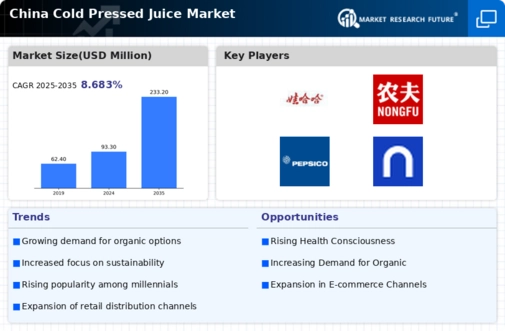Rising Health Consciousness
The cold pressed-juice market in China is experiencing a surge in demand driven by an increasing awareness of health and wellness among consumers. As individuals become more health-conscious, they are actively seeking nutritious alternatives to traditional beverages. This shift is reflected in the market, where the demand for cold pressed juices, known for their high nutrient content and absence of additives, is on the rise. Recent data indicates that the market is projected to grow at a CAGR of approximately 10% over the next five years. This growth is indicative of a broader trend where consumers prioritize health benefits, leading to a significant increase in the consumption of cold pressed juices. The cold pressed-juice market is thus positioned to capitalize on this trend, catering to a demographic that values health and wellness in their dietary choices.
Innovative Product Offerings
Innovation plays a crucial role in the cold pressed-juice market in China, as manufacturers continuously develop new flavors and formulations to attract consumers. The introduction of unique blends, functional ingredients, and organic options has expanded the product range available to consumers. This innovation is not only about flavor but also about health benefits, with many products now fortified with vitamins, minerals, and superfoods. The cold pressed-juice market is witnessing a diversification of offerings, which is essential for capturing the interest of a broader audience. Market data suggests that innovative products can lead to a 15% increase in sales, as consumers are often willing to pay a premium for novel and health-oriented options. This trend indicates that the industry must remain agile and responsive to consumer preferences to sustain growth.
Increased Distribution Channels
The expansion of distribution channels is a key driver for the cold pressed-juice market in China. With the rise of modern retail formats, including supermarkets, health food stores, and online platforms, consumers have greater access to cold pressed juices than ever before. This increased availability is crucial for market growth, as it allows consumers to easily incorporate these products into their daily routines. Recent statistics indicate that online sales of cold pressed juices have increased by 25% in the past year, reflecting a shift in consumer purchasing behavior. The cold pressed-juice market is leveraging these distribution channels to enhance visibility and accessibility, thereby driving sales. As more consumers discover the benefits of cold pressed juices, the industry is likely to see continued growth through these expanded distribution networks.
Urbanization and Lifestyle Changes
Urbanization in China is significantly influencing the cold pressed-juice market, as more individuals move to urban areas where lifestyle changes are prevalent. The fast-paced urban lifestyle often leads to a demand for convenient, healthy food options, including cold pressed juices. As urban dwellers seek quick and nutritious alternatives to traditional meals, the cold pressed-juice market is well-positioned to meet this need. Data shows that urban consumers are 30% more likely to purchase health-oriented beverages compared to their rural counterparts. This demographic shift is driving the growth of the market, as urban consumers prioritize health and convenience in their dietary choices. The cold pressed-juice market must adapt to these changing lifestyles to capture the growing urban consumer base.
Growing Interest in Organic Products
The cold pressed-juice market in China is benefiting from a growing interest in organic products among consumers. As awareness of the benefits of organic farming practices increases, more individuals are seeking out organic cold pressed juices that are free from pesticides and synthetic additives. This trend is particularly strong among health-conscious consumers who are willing to pay a premium for organic options. Market Research Future indicates that organic products can command a price premium of up to 20%, which is advantageous for the cold pressed-juice market. The increasing demand for organic juices is prompting manufacturers to source organic ingredients and promote their products as healthier alternatives. This shift towards organic offerings is likely to enhance the market's growth trajectory, as consumers increasingly prioritize quality and sustainability in their purchasing decisions.















Leave a Comment